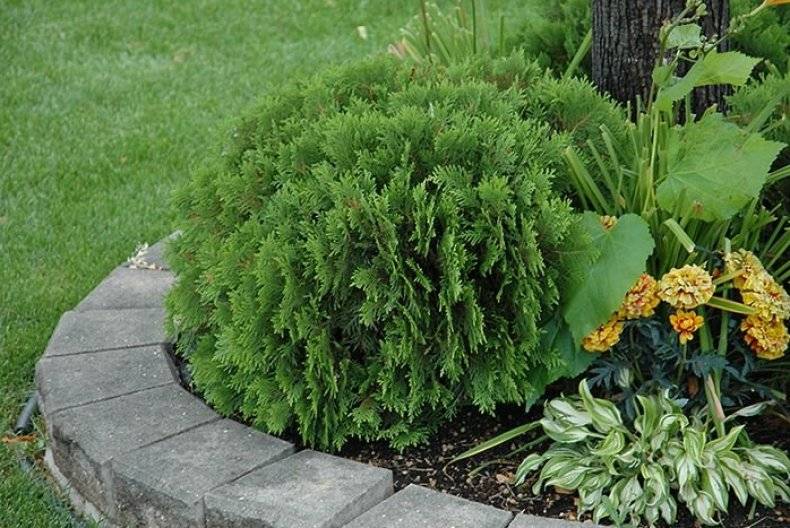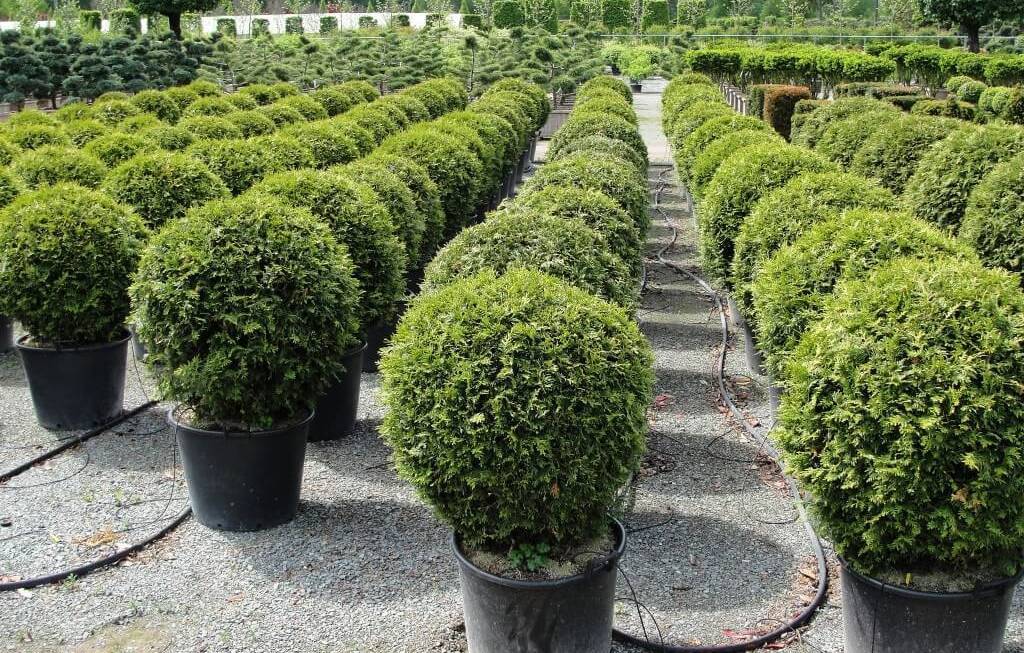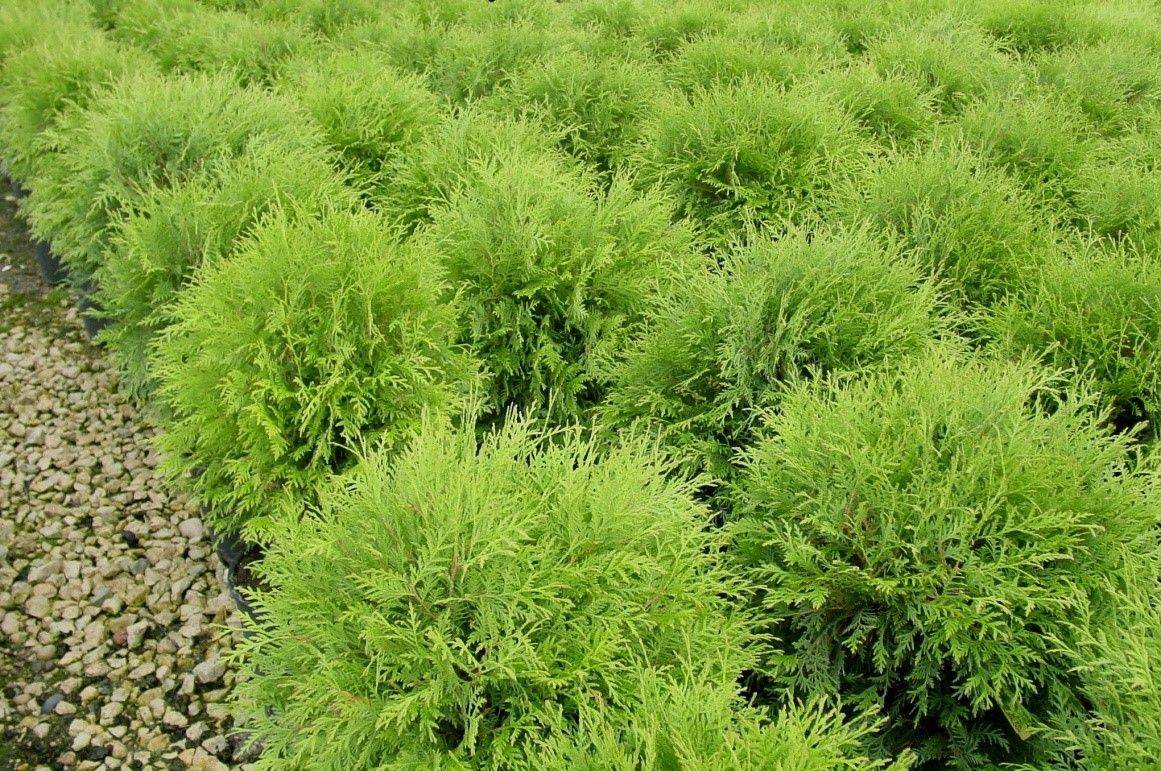Thuja spherical western - description of varieties
Content:
In landscape design compositions, you can find a beautiful low thuja with a spherical crown. She is able to attract attention in any style. The spherical thuja does not require complicated care and is known for its longevity. How to choose a suitable variety for growing, what to look for when leaving - this article will tell you in more detail.
Description of western spherical thuja (round)
This shrub has good frost resistance. A characteristic feature of the appearance is the rounded crown. In some varieties, it persists throughout life, but there are also those where this occurs only in the first years of life.
The needles are usually nice-smelling scales.
For growing shrubs, abundant sunlight is not required.
Types and varieties
This plant is widely used in landscape design. Thuja globular has been actively cultivated for over a hundred years. During this time, breeders around the world were actively engaged in the development of new varieties with their own characteristics. The following is about the most popular of the globular thuja varieties.
Danica
The bush has the shape of a slightly flattened ball. This spherical thuja grows up to 80 cm, and the width of the crown has a diameter equal to one meter. The plant reaches its maximum height at the age of 15.
Golden Globe
It is relatively easy to grow this variety due to its unpretentiousness. Golden Globe is a dwarf shrub that grows at a slow rate. Thuja needles spherical have a bright green color that attracts attention. The spherical shape of the crown remains throughout the life of the shrub.
Globoza
Thuja Globoza has been cultivated since 1874. The plant height does not exceed one and a half meters. Visually, this variety of thuja looks like a ball. It looks a bit like a juniper.
Tinny Tim
This variety is in good harmony with various landscape compositions. Breeders have developed this variety in such a way that it has a very slow growth rate. Scaly needles with a gray-green color. It remains constant regardless of the season. Shoots have the ability to branch well.
Teddy
In a shrub, the crown has a spherical shape. Tuya Teddy is a long-liver, her age can reach a hundred years or more. Small needles on thin shoots have a bluish-green tint. The roots are widely branched, they are found in the upper layer of the soil.
Miriam
The height of this yellow spherical thuja reaches 0.8 m. Its crown is also 0.8 m wide. In a year, the shoots grow by 5-10 cm. The needles have a golden green color. In winter, the color changes to yellow-orange. In spring, thuja Miriam regains its former color.
Woodwardy
The needles have a rich color that persists constantly. The crown of young plants has a spherical shape, then gradually stretches out. The shrub reaches half a meter in height over a ten-year period. This variety is characterized by high frost resistance and is able to grow in most of the territory of Russia.
Bodhi
This variety is relatively tall. Tui Bodhi's description says that it can grow up to 3 m in height. This plant has a high winter hardiness. In landscape design, they are usually used for single plantings or as a background.
Planting and caring for spherical thuja
Spherical thuja is not only a beautiful plant, but also a plant that is undemanding to complex care. It is important to plant the shrub so that it takes root. To do this, you need to choose the right time and a suitable site. For a round thuja, planting and care should be carried out in accordance with the rules.
How to plant spherical thuja
Although thuja western globose is not demanding on light, with sufficient lighting it will develop more confidently. For a spherical thuja, you can choose a shady area, this will not harm the plant.
It is necessary to pay attention to the absence of strong winds and drafts. A good choice would be a plot on the east side.
When planting, you need to make top dressing, ensure high-quality drainage.
The best time to land in the Moscow region is August. In more southern regions, in the Krasnodar Territory, in the Kuban or on the territory of Ukraine, this can be done throughout the year.
Watering mode
At first, weekly watering requires no more than 10 liters of water per bush. During the first year of life, the thuja ball needs a regular supply of moisture. As soon as the topsoil dries up, it's time for a new watering. For an adult plant, you need 50 liters per week.
In this case, it is important to ensure that there is no waterlogging. If this happens, the roots may begin to rot.
Top dressing
During the first years of the life of a spherical thuja, those fertilizers that were applied during planting are enough. In the fourth year, they begin to make top dressing. In the spring, you can use the wagon kemira. For 1 m², 100 g of top dressing is required.
Features of caring for a spherical thuja in summer
In summer, in hot weather, you can increase the number of waterings up to twice a week. The plant will benefit from crown irrigation.
The soil should be regularly loosened and covered with mulch. To care in this way, colored sawdust is sometimes used.
Pruning old and dried branches is done in April.

In order for the shrub in the flowerbed to look just as impressive, it must be properly looked after.
Preparing spherical thuja for winter
In order for the spherical thuja to endure the winter well, it needs help. For this purpose, a thick layer of fallen leaves is poured onto the roots around the trunk. It must be remembered that the roots of this plant are close to the surface, therefore they can be damaged by too much frost.
In early spring, dry leaves must be removed.
Reproduction of spherical thuja
The most popular way to propagate shrubs is by using seedlings. If you plan to plant seeds, then they need to be purchased in specialized stores. This is important because when using self-seeding, the species characteristics of the parent shrubs are not transferred to the new plant. In order to obtain seeds with the desired qualities, specialists must work on this.
The easiest way to propagate a growing shrub on the site is using cuttings.
Propagation by cuttings
The planting material is obtained in the fall. To do this, take sprouts up to half a meter long. It is desirable that they have a well-formed heel.
For germination, a mixture of sod land, crushed peat and sand, taken in equal parts, is used. The stalk is buried a couple of centimeters and covered with a film on top. This requires watering and good lighting. When the roots appear, the cutting will be ready for planting.
Why do spherical thuja turn yellow
There may be several reasons for this:
- in some situations this may be a natural process. The needles have their own lifespan. When it comes to completion, the color changes. This does not indicate any problems with growing in the garden, but is a common occurrence. In place of the dried and fallen needles, a new one should appear;
- sometimes the color change with the arrival of autumn and winter is a property of a particular variety. When spring comes, the plant will return to its former form;
- however, when planting and grooming errors are the cause of the yellow color, close attention should be paid to this. Planting a bush on sandy soil may be one of the possible reasons. Another common situation of this kind is lack of drainage.
If the culprit is gardener's mistakes, it is necessary to determine what the plant needs and correct the existing problem.
Thuja globular combines a decorative appearance and unpretentiousness in care. If a gardener chooses this shrub to grow, he will receive a valuable plant for design compositions.



















